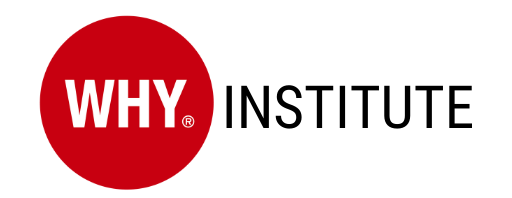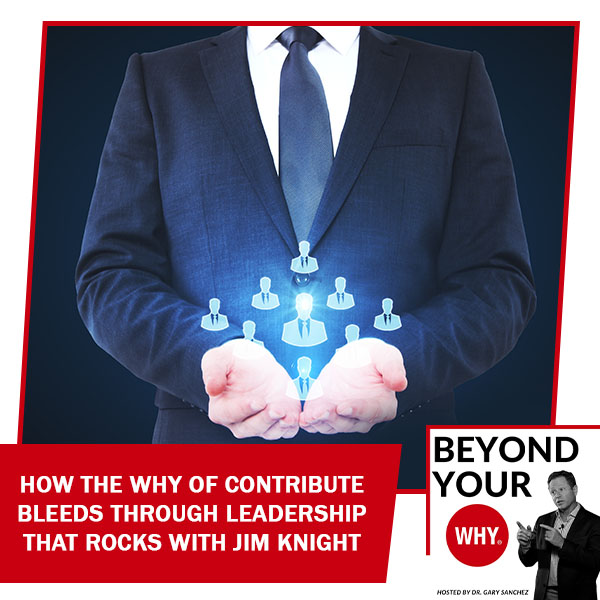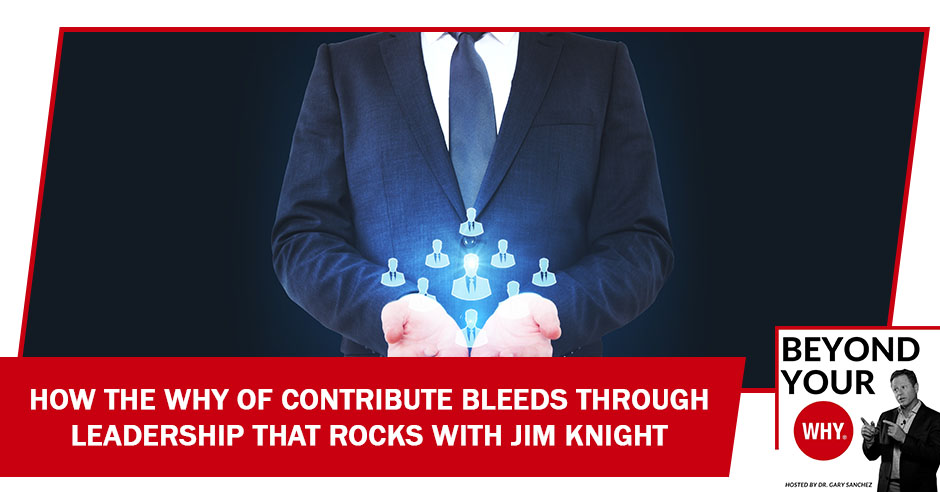
Jim Knight has upheld a passion for contributing in any way he can, anywhere he can. How does that bleed through and influence his work? Jim is a keynote speaker, coach, and author of Leadership That Rocks: Take Your Brand’s Culture to Eleven and Amp Up Results. He spearheaded Global Training for Hard Rock International for two decades and now teaches organizations how to attain their own rockstar status. In this episode, he joins Dr. Gary Sanchez to share how he’s morphed his passion for serving with his experience in HR. Jim talks about leadership and its relation to culture in his latest work. Tune in as he gives tidbits of insights from his book and more on creating a culture that attracts rockstars!
—
Watch the episode here:
Listen to the podcast here:
How The Why Of Contribute Bleeds Through Leadership That Rocks With Jim Knight
In this episode, we’re going to be talking about the why of contribute. If this is your why, then you want to be part of a greater cause, something that is bigger than yourself. You don’t necessarily want to be the face of the cause but you want to contribute to it in a meaningful way. You love to support others and relish the success that contributors make for the greater good of the team. You see group victories as personal victories. You are often found behind the scenes, looking for ways to make the world better. You make a reliable and committed teammate, and you often act as the glue that holds everyone else together. You use your time, money, energy, resources, and connections to add value to other people and organizations.
Now I’ve got a great guest for you. His name is Jim Knight. He teaches organizations of all sizes how to attain their own rockstar status. Although his illustrious career started at Gatorland Zoo in Florida and he has the scars to prove it, he cut his teeth in the hospitality training industry and eventually led Global Training for Hard Rock International for decades. His customized programs show how to amp up organizational culture, deliver world-class differentiated service and build rockstar teams and leaders.
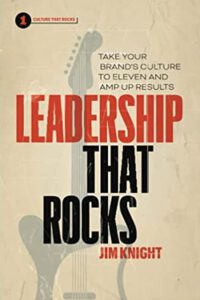
He’s known for signature spiky hair. He is the bestselling author of Culture That Rocks: How to Revolutionize Your Company’s Culture. It was featured in Entrepreneur Magazine as one of the five books that will help you transform how you do business. His new book Leadership That Rocks: Take Your Brand’s Culture to Eleven and Amp Up Results launched in May of 2021. A portion of his book sales, podcast revenue, speaking fees, and training programs proceeds go to No Kid Hungry and Cannonball Kids’ Cancer. Jim, welcome to the show.
Thank you so much, Gary. I appreciate it. I don’t know that I gave you the long bio. That was quite an introduction, but you touched on a couple of things that are probably going to fit into our conversation. First and foremost, I’m thrilled to be here. Thank you.
First of all, you can’t see Jim’s hair so I’m going to try to describe it. It looks to be about 5 to 6 inches tall, perfectly straight up, and multi-level, multi-colors. How the heck did that come about and how do you do it?
I probably have always been known for my hair and since I’ve been an adult. Once I started to work on my music degree and for 21 years, I was at Hard Rock International. We had a chance to look, be, say and do whatever. I worked with The Island of Misfit Toys. Believe me, this hairstyle is safe compared to a lot of my rock and roll friends with piercings, colored hair, bollocks and the whole thing. I used to have long hair. I had a mullet and I could sit on my hair about 2.5 feet at one point, then I decided several years ago to grow up a little bit and started speaking professionally. I went up so it’s got some spikes in there.
To answer the second half of your question, it is multilayered. I have somebody who does the hair once a month. She uses razors instead of scissors and that’s the first secret. The second is I use this product called Got2b Glued. I’m sure a lot of people in your audience probably have seen this before at CVS, Walgreens or Walmart. It’s in a yellow tube. It’s the same look, smell, feel, and consistency as Elmer’s Glue. I throw that stuff in there a little dollop and 30 seconds later, this is what you get. It’s like Sonic The Hedgehog all day long. This thing is hurricane-proof in Florida.
You go to bed looking like this. What do you look like in the morning?
It’s almost the same. I took a shower in the morning but if I go to sleep like this and I was laying on one side, it might get a little bit matted. You can throw some water in there and it reconstitutes the glue. If I wanted to, I could not wash my hair for 3 to 4 days and it would still be spiky like this. I’ve lived pretty well on Survivor for about 3 to 4 days. After that, it’s sad and it gets weak and flat. Water is my nemesis. If I jump on a pool, it’s game over.
Take us back to when you were a kid. Where did you grow up? How did you get into hospitality? Take us through the quick version of your life back when you were in high school.
[bctt tweet=”At the heart, culture is about people.” username=”whyinstitute”]
My quick version is I wanted to be a musician. When I was in middle school and high school, I started thinking about wanting to perform. I did a bunch of community theater. I did go to school and have my Music Degree in Associate of Arts, Music, and Education. My first job was at Gatorland Zoo. I live in Central Florida so I live in the land of theme parks, Disney, Universal Studios and SeaWorld. There are like 27 theme parks here in Gatorland. It’s one of the best-kept secrets. That was my first job. While I was doing that in the summertime, I started to go to college. While I was at university to make a living, I found out that being a musician, you had to be good, so I changed careers.
They say those that can’t do, teach. I became a middle school teacher and did that for six years. I’m a product of public education and I’m happy to have taught in that. Eventually, I needed to make some money in the summertime. As you can imagine, teachers don’t make any money in the summer. I take a little summer gig at Hard Rock International. The Hard Rock Cafe at that time was the new thing in Orlando. It’s the busiest restaurant in the world. I was a host deceiving people. I did that for a year. I became a trainer. They paid me to start traveling and opening up Hard Rocks around the world, Madrid, Mexico City and Paris. I got to hang out in London.
I traveled the world as a kid. A couple of years later, I became a manager and was running shifts for that building, which does anywhere between $42 million and $45 million a year, which is unheard of in hospitality. Your skills get sharp. Your head and ego get big. You’re hanging out listening to 90 decibels of Zeppelin and meeting rockstars left and right. It was a gas to do that. Within a year, I went over to the Corporate Sports Center and ran training and development for them. That’s the long answer. The short answer was several years ago. I decided I wanted to have a little bit of a louder voice and I wanted to contribute more to society.
I still pull the levers of music, education and hospitality. I put all of that together to make this edutainment in the programs, whether it’s something as a writer, eLearning and certainly as a keynote speaker. Several years ago, I left. Instead of being in hospitality, I wanted to go vertical. Now I speak in front of bankers, insurance agents, clowns, and funeral directors. If there’s an association and they’re looking for a speaker, I want to go out there and talk about culture, service, building teams, and those types of things. Leadership is hot and heavy right now.
What did you notice that Hard Rock did better, different and unique that allowed them to scale to $40 million to $50 million per restaurant?
I would say that’s probably three. You usually would take New York and Los Angeles. Las Vegas was probably one of those, as well as Orlando. Those four would do those types of numbers. Everybody else is between $7 million and $20 million, depending on the market. You had to be in a big A-location. That was what Hard Rock started with. They’re now in a lot of C markets. They’ve decided that there’s a lot of earth where they can plant their flag.
They’ll bring the Hard Rock brand to a country or a market because some people in these countries aren’t ever going to travel to Western Europe or the US, which is predominantly where the Hard Rock is. Their future is all franchise cafes. Although a lot of people still go, “Hasn’t that thing been around for 50 years?” They have and they’re still opening up properties, but the future for that brand is hotels and casinos for sure. That’s where all the money is.
Particularly, a casino will do what ten hotels do. That’ll do what twenty cafes will do. You’re limited on where you can do that in the world. To answer your question, Hard Rock is cool as I thought it was. To me, it’s still one of the awesome, great brands in the world. The product is fantastic. I love the environment, the music, the memorabilia, the retail, all of that stuff is cool. None of the buildings are the same. There’s no cookie-cutter. They build pyramids, inherit castles, and they put a bar on the side. It’s crazy. It’s always about the people.

The silver bullet for them is, I’m going to find the most unique people I can find because unique people bring some unique experiences to the party. They’re also going to make sure that these people have tremendous work ethic. It’s not just because they’re freaky people and they look different, which by the way, you see more companies starting to do that now. I’m thankful that I worked for a company for two decades that was doing that before it was popular, allowing tattoos to be seen, crazy colored hair, being on a first-name base with the boss, pushing back, challenging the status quo, and not having any fear of something happening to them. All of that stuff mattered. When you can do that, do you know what you get with the team members? They stick around and that’s loyalty.
Hanging out with that interesting collection of humans, and the value orientation that the company had were the two things that kept me going. I’d say it’s a tag team. It’s the unique people they went and found, but also the values like save the planet, take time to be kind, and all as one. These were emblazoned on the walls for no other reason but to keep us all honest. That allowed me to want to stick around a little bit longer and invite my buddies to come and work with me.
How did they go about finding all these unique people? What was their process or thinking behind that? Was this something that came about randomly? Was it a strategic thing that they thought or you thought about? At one point, you were running one of them. How did you do it?
I was running shifts in the mid-‘90s but I ran global training for the whole brand. I wasn’t running all of the individual properties. I came in in the early ‘90s. The thing started in 1971. There were two Americans that were hanging out in Great Britain and they had two issues. They couldn’t find a great burger. They wanted to make sure they had a little bit of some of that greasy Tennessee Truck Stop, Southern-style food that you couldn’t get in the UK at that time.
There was also not a big middle-class in the United Kingdom. You were either very rich or very poor. The fact that there were two lines for people, if you were rich, you stood in this line, if you didn’t have any money, you stood over here this line, they didn’t like that. That was red meat for some civil rights activists people that were coming out of the ‘60s. You know what was going on in our country. Those were the two reasons I did it.
To answer your question, it was extremely strategic. They will have the best food, shakes, environment, they’re going to put music in there, but their real goal was, “Let’s go find some people that were unique.” Ironically, they didn’t go youthful. Every single 1 of the 42 original servers had to be over 30 years old and they had to be women. A lot of them were redheads. It was funny to think you got this group of older redheaded women who are slinging food around and they’re going to push back a little bit.
It was a little irreverent and unpredictable but then even as time went on, their goal was, “Where can we go find some rockstars? Maybe it’s outside of the usual. Maybe it isn’t going to be another restaurant. Maybe I will go find somebody in tattoo parlors or concert halls. Could I go and find some in a retail location that had no food and beverage background at all.” They wanted people to have some experience but they certainly wanted to populate it with unique humans that had killer personalities. I almost think of the old TV show, Alice. If you think about that and you think of flow, some of your audience members may be old enough to remember. It was chewing gum and pushing back on everybody.
If you could find that person somewhere in your sphere when you went out to eat, drink, shop, stay, play or do whatever, coerce them, convince them, and pay them probably a little bit more to come work for you. All of a sudden, you’ve got a rockstar. You got a diamond in the rough who is probably going to create some unforgettable memories. That was their goal. It was completely strategic. I hope the brand is still doing that. I haven’t been there for years. That would be a miss if they stopped hiring some interesting humans.
[bctt tweet=”“You want to have a fantastic, awesome culture?” Number one, you got to go find some rock stars. That’s got to be your absolute focus more than anything.” username=”whyinstitute”]
It worked awfully well for them. You were there for two decades.
I started in April of 1991. I left in April of 2012.
What was it like for you to leave that comfort and start speaking? The middle school teacher gone culture, spiked-hair guy is now going to go speak to who?
I was crazy nervous. I had a little bit of some tricks up my sleeve. Part of it was the last several years before I left Hard Rock while I was the Senior Director for training and development, I had a great team of nine people. I started speaking on the side at that time. The very first one, like almost every speaker out there, we do it for free. Somebody asked me to come to do a little mini-orientation at Hard Rock. It had nothing to do with what I talk about now. No leadership, services or any of that stuff. They just wanted to have somebody do the Hard Rock story because they lived in a state in the US where there wasn’t property. I was like, “I’ll go do that. I’m not going to send my team.”
What happens is what happens with everybody. I went and spoke and somebody in the back of the room came up afterward and said, “That was awesome. Can you come to do it for my company? How much do you charge?” That’s when the light bulb went off. I started charging people, but here’s the cool part. I never took any money. I gave the brand. I gave Hard Rock all of the money because I wanted it to be above reproach. I never wanted my boss, the CEO or anybody to ever challenge me and say, “He’s having fun doing his side job than doing the regular day-to-day stuff.” It did allow me to feed the beast, get my sea legs, and get a lot better at platform speaking.
I was sharing stuff that I loved. I was impacting and influencing audiences to check out Hard Rock. Maybe they didn’t even know about the brand. Everybody wonders, don’t I actually get paid? I just put it into my budget. In training people, we spend money. To be a revenue-generating initiative was great. I never went over budget. My boss always loved it. What you probably would imagine did happen to me was I started loving that gig a lot more than the details of the day-to-day making the donuts.
I’ve decided to jump off since I was already doing it. I was doing about one a month. I had a couple that was ready to go when I jumped off. I was scared to death thinking, “I’ve got a cool job. I traveled the world. I’m getting paid well and looking at all the benefits. Am I going to leave all that because I think somebody will pay me maybe the same amount? I’d be happy if it would’ve been the same amount. Am I going to do that for a living?” It was crazy. I jumped off the deep end and I’ve never looked back. It’s been fantastic for me.
The platform that you started speaking on was culture.
It was the Hard Rock culture. If I got to be honest, I was pulling the lever of the brand. I tried to immerse people in the spirit of rock and roll. That’s where I probably got my focus more than anything else. It was on culture, which then led into some of those other things, service, leadership, building rockstar teams, that type of stuff. I’ll probably forever be known as the Culture Guy, and that’s cool.
What is it that makes a good culture and why is a good culture important?
We alluded to this already. If I was ever going to write or talk about it, I do define exactly what culture is right upfront. If you and I did a survey of your audience members or even if I asked you right now, “What do you think it is?” I will probably agree with you. I’m in the everything is culture camp. They can be all of the stuff that I mentioned before. At the heart, it is about the people.
Let’s say you’re a legacy brand. You’ve been around for 15, 20, 40 or 100 years. It doesn’t matter. If I were to have held on to the exact group of people that started the thing in the first place, you’re the founder, the president, the CEO, you’ve been doing it for 40 to 50 years, you could have held onto that group. You’d have the exact culture that you want. If you fast forward a couple of decades, it doesn’t work like that because people come and go.

I know that if I was to keep all of my awesome people but change everything like logo, font, corporate sports center, tools, process, employee handbook, eLearning or whatever it is, but I kept my people, I wouldn’t make a huge dent in the culture. I’d have exactly what I want. Let’s say that I love all of that infrastructure. I keep all of that stuff but I kick everybody out in the organization and replace them with a bunch of other people. I’ve completely revolutionized the culture
I will talk about a lot of nitty-gritty details but I can’t emphasize enough when I’m in front of an audience saying, “Do you want to have a fantastic, awesome culture? You got to go find some rockstars.” That’s got to be your absolute focus more than anything else because the rest of the stuff is you being a good manager but you’re not thinking like a business owner, entrepreneur, big brand. You’ve got to love on them. You’ve got to do everything in your power not to muscle the result and manage the threats, punishment and fear, which I still see out there in a couple of industries.
If you can throw your arm around people, teach them, and have a little bit of a heart-centered mindset, they stay with you longer. There’s a direct correlation between turnover and top-line sales. It’s not just in hospitality. I’m starting to see that in almost any industry. I know that’s a long answer but it’s always about the people. Do I want to focus on all the other stuff? Totally, but those are the little rocks. The big thing that makes a difference is I got to populate the thing with people who can slake it. They’re showing up going, “I’m in the memory-making business now.” They show up and do that every day, “I’m going to put Herculean results.”
When you’re leading the team and you’re trying to love on them, but you’re not getting the result you want. How do you handle that? I’m sure there are people reading that are dealing with this. Their key person isn’t quite doing it like they were, could or you wanted. How do you love on them yet get results?
First, I’d look in the mirror. Maybe the common denominator is the leader. Sometimes, I’ve got to change their tactics or they’ve been doing it the same way. They’re banging their head against the wall going, “How come they’re not responding to me?” This is why you go to conferences. You read books and listen to podcasts because the more that you can be open-minded to change and you can put more arrows in your quiver, you’re more likely to look somebody in the eye and go, “This is what it will take with this person right now that rock their face-off.” I would say that anyway from an end-user, a guest or a customer but we have to think the same way from an employee.
These associates and team members have different needs. For some of them, it might be a tiny little bit more money. Others need you to spend a little bit of time with them, look them in the eye, care about them, and ask them about their family and what did they do this weekend. Others want development. “Put me on a fast track. Give me a program so I can start hitting some things to ultimately become promotable.” It doesn’t guarantee me the job but it’s less likely that you’re going to go to the outside if I’ve been on the AAA Ball Club and I’m ready to be called up.
There are a variety of things. It could be surprising them with small little things, whether it’s buying sometimes a lot of tickets, stopping and getting an Icee or a Slurpee on the way. Sometimes it’s doing contests and having fun when you’re at work. Maybe it’s dressed down day. Maybe you’re allowed to have a company dog or you change the benefits in favor of them where it doesn’t cost you a lot of money. There are many things.
I have an entire chapter dedicated sometimes with all of these ideas bullet-pointed. I freely admit and go, “Please don’t do all of these. It’s ridiculous, but pick and choose the ones that would make sense from a tactical standpoint.” If leaders just sat back and thought, “I need to say thank you a little bit more. I need to tell people they rock. I need to care about them as a whole person and let them be seen.” Have discussions that if something is not working, don’t be freaked out about it. Come to me and let’s figure that stuff out.
[bctt tweet=”It isn’t about competence anymore. It’s not just about character. You need all three Cs: competence, character, and culture fit.” username=”whyinstitute”]
Sometimes it’s the easy and free things that would make a difference. This could be a whole episode discussion for me talking about how to keep employee engagement going and loving on people. When I say love on them, it isn’t just throwing your arms around them and going, “Come on, guy or girl.” It’s not about that. When people feel like this person does care about me, and there’s a relationship and trust factor, I’m willing to follow that leader off the edge of the cliff. When they do leave the company, I’m going with them.
What’s interesting is your perspective on this is right in line with the why of contribute. You look at it from the perspective of, how can I help you? How can I make your time here more fun, better and more productive? How can I be part of your success? Not every why sees it that way. It’s interesting to see leaders from how they think. It would make sense to somebody who’s why is contribute. Of course, I would do it that way but somebody else would look at it and say, “That seems like a lot of extra effort for trying to get them to do what I paid them to do.”
This is why your show is great because I love the idea that you take in these different tenets and you look at these and go, “Let’s dissect it. Let’s talk about each one.” If you take any of these personality assessments, DISC, Colors, Myers-Briggs, Franklin Covey, you name it. Everybody realizes there have to be different types of people on the team. If all of us were wise, there would be a lot of kumbaya and we’d be giving a lot, and nobody would get stuff done. I realized that but it’s been part of my DNA. I’ve always been like that because of my parents. Probably a little bit because of religion and going to church early on.
It’s certainly working for a brand that did not have a single marketing initiative that didn’t have some type of philanthropic charitable component. A lot of people don’t know that and they never wanted to scream from the top of their lungs but I knew. My Hard Rock buddies all knew and that’s part of the reason we stuck around. I love the idea of giving back if for no other reason but propping other people up because I know that it’s in my interest. Sometimes they’re not a part of my inner circle. It’s just I want people to succeed. By the way, I’m a consumer. I personally am an experiential starved consumer.
When I go out in shop land, I care about the store, the restaurant, the hotel or the place I’m going. It doesn’t matter. I want to be around awesome people. There are some small ways that I can give back, whether that’s a nugget of information, advice or some real mentorship. I’m all about that. Sometimes, it’s money too. I don’t mind helping people out. That’s how I’m wired and I get it. You’re right. There are going to be some that are like, “Not my bag. It’s not my gig.” That’s okay. I sign up for that. I’m the one who volunteered to say, “Put me in that role.”
It is what we were talking about the why of contribute. You use your time, your money, your energy, your connections to push other people forward. That’s the essence of how you view the world, which is awesome why for what you do. Let’s transition that a little bit into leadership. What is leadership from your perspective and what makes a great leader?
It’s probably like culture. These are both esoteric and nebulous words. Everybody’s got a different opinion about it. I’ve taken the slice of leadership from creating, maintaining or even completely changing and revolutionizing a culture. I had to start with that because that was a little bit of my background. I have been to many courses and I’ve seen many things. You talk about the difference between a manager and a leader. There are many important elements that come out of that.
Probably the number one characteristic that I see more than anything else is somebody who is trustworthy. If you trust that person, they’ve got a good shot of having some leadership. You’re trustworthy. Therefore, I trust you and all the other awesomeness in our relationships happens from there. The book that I wrote and the things I talk about are trying to dissect several of those. What does critical decision-making look like when you get to a point and you’ve got to make a decision?

Is it time for me to be quiet, subtle, cool and humble? Is it time for me to be loud, over the top, grandiose, and bring the thunder? It’s different for different moments. Can I be heart-centered? Can I still get things done? Could I still marshal the resources that I need but do it in a caring, loving and kind way where it’s the carrot versus the stick? I remember back in the ‘80s. You can push people uphill and you can muscle the result. Those days are long gone.
Gen Z or even if you still go back to the Millennials, they’ll laugh at you because a rockstar can always get another gig. As employers, we need them a whole lot more than they need us. Sometimes, the way that you treat people is the linchpin. They’ll go, “I’m out of here.” They’ll go right up the street and probably work for your competitor. I think about that from a leadership standpoint. I think about mentorship. I’ve gotten to the point that I almost dissect that into five different areas. You could be an internal, external, peer, public mentor. You could even be a reverse mentor. You can learn a lot from somebody that you’re mentoring. I have somebody who’s 25 years my younger and I learned from that person all the time.
Even having an unparalleled work ethic, which I know some people are going to throw certain generations under the bus. I don’t want to do that. I liked being extremely positive and also probably contribute to my contribute. I do think that there have been some things that have been lost. Sometimes, having a little bit of a pep in your step, a sense of urgency, attention to detail has been lost a little bit. I know it’s not always taught by parents. It isn’t being taught anymore in public education. If you’re not in charter, private school and in public school, I don’t know where you get that.
I used to think I was a good trainer. I cannot train people to have a personality and I can’t train you to smile. Either you have it or you don’t. If the juice isn’t running through your veins, you’re going to be impaired. You’re going to not be of use to me unless there’s a place for you in the back where no one will ever see you, which is highly unlikely. I need people to have a little bit of this work ethic mentality.
I have a good friend of mine who runs a frozen dessert concept in Chicago and it’s populated all with Gen Z employees. They’re young and they don’t have a lot of these skills. She has to make the decision to go, “There’s no way I’m going to hire you. I’ll move on to somebody else or I see something. I see the personality a little bit. They might be a diamond in the rough. Maybe I’m going to be their first and best job. Maybe they’re going to always think favorably. Maybe when they finish college, they want to come back to be a manager.” She’s made a cognizant decision from a work ethic standpoint. If they didn’t get to somewhere else, let me be that person. She almost probably has the same mentality. I bet her why might be contribute as well.
I think about those things, how can you be a catalyst for change? I talk a lot about change because times are changing. Changes are coming. You can either freak out about it. You can run away from it. You can lean into it. You can be a part of the change, or you can prepare the team for it. I spent a lot of time talking about that stuff. I don’t know if I rattled off 4, 5 or 6 things, but I try and chunk it down. If I’ve got time, an hour keynote, a three-hour workshop or somebody is flipping through the book, at the very least, they go, “I get it.” It’s in the sphere of culture but around work ethic, a heart-centered mindset, or critical decision-making. Could I be a catalyst for change? Can I enlist in some mentorship because maybe my company doesn’t have that? How can I go to the outside and make that happen? Can I think about everything that happens to me be a personal culture shift? Things are happening to me or things are happening for me.
You use the analogy of Shrek. Life is like an onion. There are layers in there and every time something happens to you, you can either be mad or you can be like, “This sucks but it’s okay. I’m going to use this to my advantage. How can I get better? How can I make sure I don’t make any more mistakes?” I ran off on a tangent there, but leadership is the number one characteristic. If I can trust you, then I’m willing to follow you. Now I’m more open-minded to doing the things you need that I might not have done on my own.
What part of being a great leader comes back to who you hire? Is it you can take anybody and lead well?
I’ve always been to the camp that there are three types of people. There are people who don’t know, can’t do, and don’t care. If it’s a don’t know, you can train about anybody. It’s a knowledge dump and there are many different ways to do that. Somebody might be visual versus auditory. Maybe they need a little bit more time, whatever it is. The don’t knows, I can deal with.
[bctt tweet=”All the best training in the world isn’t going to help a bad hire.” username=”whyinstitute”]
The can’t dos is where leaders tend to get a little bit frustrated because you try. Maybe you are somebody who gives somebody 2, 3 or 4 opportunities but they can’t do the gig. A lot of them are willing to cut ties and move on. I would see if there’s a place for them somewhere on the bus. Do they maybe have a skill? It’s the old Marcus Buckingham Gallup approach. Can I focus only on their strengths instead of pointing out their weaknesses because everybody’s got strengths? Do I need that on the team?
The can’t dos is tough. You might have to cut ties with them, but there’s also a whole bunch of don’t cares out there. I have no love for them. As a leader, if somebody were smart enough to think, “I’m going to focus on every area of the employee life cycle but at the very least, I’m going to focus on the front end. How I recruit, interview, what’s my stereotypical employee, how do I hire, and how do I train? Before I step back and go, “They’re an employee. I don’t have to watch them anymore.”
There’s a lot of things that go into place from recruiting collateral, non-negotiable interviewing standards. Do you know what you’re looking for? Because it isn’t about competence anymore. It’s not about character, although those two C’s I care about a lot. Now, I didn’t think about culture fit. You need all three, competence, character, and culture fit. If the leader is smart enough that they’ll go and find great people, then all the other stuff falls into place.
If you’re asking me, could I be a great leader and still do it through the product being first to the market, keeping everything clean? Is it just a physical building? How do I handle stuff when it’s online or on the phone? Regardless of what the product or the industry is, there are certainly a lot of things that I would do. I do care about the 997 things that somebody should be focusing on if they’re in a position of power. If I can’t get some end-user to think about the last three questions that always show up on a survey, “Are you coming back? Are you spending more money? Are you going to talk about me positively?” If I can’t get them to say yes to those three, I haven’t created a memory. I haven’t created some incentive for them to come back.
That’s another long answer. There’s a lot that somebody could do. I am now a firm believer, and I study and love many brands that I have huge crushes on. I have fallen madly in love with some great cultures out there who now swear that the only reason they are the way they are and their cultures is because of their people. You can steal all the rest of this stuff but if you can’t get my people, you’re never going to be able to replicate what we do.
Here’s a great example, Southwest Airlines. I cannot understand why every airline has not copied their onboarding and their departure processes. How they bring people on because they’re still number one in departures, landings and arrival. They’re still the most profitable airline out there. They have some fun when they’re doing safety announcements in their uniforms and all that stuff. Just the fact that they have no fees for baggage and they can onboard everybody quickly. Nobody else can figure that out. I go, “Why haven’t they done that?”
Let’s say they did do all that. They can do every one of those. If they can’t take the Southwest employees, all you’re doing is moving the deck chairs around on the Titanic. All you’re doing is changing and swapping systems. You’re not focusing on human behaviors, which are all learned human behavior. They’ve done a fantastic job getting the right people and that’s why I’m a fan of their still.
The next question I was going to ask you led right into that. Do people have it or don’t have it? Maybe you answered that with the three types of people but I’m wandering back to training. How much training do these organizations do? Let’s take Southwest Airlines. How much training do their team go through before they meet a customer? Is it a little or a lot? Do they hire somebody who already got those skills? How does that work?

They do a lot. When you’re looking at travel, you’re going to spend a lot more time because of the safety requirements that are in there. It’s probably even more than whatever the stuff is. My knowledge base is way more around retail, hospitality and theme parks. That’s what I learned and I sat on the certification governing board of the National Restaurant Association. I have to say the long way because if I just say NRA, they’re thinking of the other NRA. When I think about the work that organization does and I’ve seen about all of these statistics, the average restaurant day one orientation is around two hours. The good ones are around three hours.
At Hard Rock, because we had much more, food, beverage, retail, local marketing, group sales, dealing with celebrities, live music and all this other stuff, we spend an entire day. I thought that was short. I wish we had two days, but it’s one-day orientation and then you started training the next day. When I hear most restaurants are doing two hours, it blows my mind. When I think about a company like Chick-fil-A, this is a fast-food chicken place. They do no training until day three. It is two days of orientation. Their story, values, vision, mission, they dunk you in the culture. When you come up out of it on day three, you’re either all in or you’re not. It starts to prove that the awesome companies out there are spending a little bit more time.
The first part of your question was, “Do you just have it?” I’m a firm believer now that you don’t. You learn everything. You and I and your entire audience are not the way we are because we were born that way. It’s the difference between us and the rest of the animal kingdom. You learn everything. You learn it from your parents, school, friends, playground, religion, lack of religion. By the time you come to me as some 18, 19 to 20-year-old kid, you either got it or you don’t. You either have the smile. You’ve got the amp to want to be around people or you don’t.
People can fake it for a while and then you become unmasked. You fall back into your natural disposition. Training and leadership help. There are some things that I can do not to fake and coerce people into doing the things I want because as a leader, most companies aren’t going to have the boss micromanaging over their shoulder. At some point, you’ve got to step away and hope that they know what they’re doing, and they can represent the company, the brand very well. I do think you ought to do all these things, train, develop, communicate, reward, recognize, and all of that stuff.
On the front end, if you don’t have people who are coming to the party with some of that oomph as you said, it’s going to be a slog. You’re going to be pushing people uphill. I still think there are people that just because of their environment, they have the ability to wing it. They can shoot from the hip. They certainly like to gab. Even those things, you got that from somebody from somewhere.
I do believe and I’m such a huge fan that everything is learned human behavior. When I’m in front of an audience, I have to go, “You’re all recruiters now. You’ve got to put on your human resources hat.” If I was honest with myself and I had a time machine, instead of being a training and development guy because I had no say in how people came onboard or how they left, I can train the best that I can with what you give me but all the best training in the world isn’t going to help a bad hire. I would push people.
I would go back in time to be a recruiter because, at the very least, I felt like I got my finger on the pulse of what I needed. I will hand them off to the training guy or girl and they’ll be in a much better place. If they don’t have that DNA, it’s going to be tough. I don’t believe that you’re naturally born with it because I’m sure it’s controversial for some people too.
I’ve got a baseball team for you to follow. Follow the Washington State baseball team. The coach, Brian Green, had taken over the worst team in the NCAA, which was the New Mexico State Aggies. He turned it around to being five winning seasons in a row. Multiple players picked it to the Major League Baseball and then he got hired away to Washington State. I’m not sure if this is correct but I think his first twelve days of practice, they don’t touch a ball. It’s all culture. That’ll be a perfect example for you as well because it’s all about the culture. That’s what’s changed the game for many of them. He speaks on that now. I’d be curious to hear what are some other good companies that you’ve fallen in love with that have a great culture. I heard Chick-fil-A, Hard Rock, Southwest Airlines. What are some others that you like?
[bctt tweet=”A single person with a great idea can start a revolution.” username=”whyinstitute”]
This is where I’m always stretching to do more outside of hospitality because I could probably name a lot of those. Your readers will probably know Zappos. They are amazing to me. They only sell shoes and do it online. They don’t even sell their own shoes. They don’t even have their own branded shoes. They sell other people’s shoes. When I see brand health studies, they’re always in the top ten. It blows my mind that their founder, the late Tony Hsieh, decided they’re going to have the best culture and customer service regardless of what they do. They sell online shoes. They get propped up quite a bit.
There’s a computer server company called Rackspace. A lot of people will not know who that is. These are tech people and IT people. They set up infrastructure companies, but yet they internally have one of the greatest cultures to the extent that some of their employees get the Rackspace tattoo on their shoulders and on their calf muscles. That blows my mind. Harley Davidson still does a great job out there. Some of my music roots, Fender and Gibson have their own unique cultures.
There are a couple of places that I love that are restaurants here locally in Central Florida. Yellow Dog Eats is one of those. I talk about them quite a bit. It’s mostly because of the executive chef, the founder. He is one wild, interesting guy. The food is great and the atmosphere is fantastic but this guy has no filter. Every time he’s in the building, he creates memories. People have discovered him when they’re out and about.
Hotel-wise, I know people will talk about the Ritz-Carlton, but I’m a fan of Kimpton Hotels. From a culture standpoint, they’re fantastic. I got to still prop up Hard Rock. A lot of people don’t even know there are Hard Rock Hotels and there’s something like 30 of those on the planet now. It’s got some of these unique people you don’t normally see in the hotel space. Those are ones that I think of right out of the gate.
I spent a lot of time with the US Air Force now. I do some stuff up at Andrews Air Force Base up in DC which is where the presidential aircraft go off. I spend time with the Brigadier Generals, all the new ones that come on board. They have a fantastic culture. If you’re probably in any of the Armed Forces in the US, they will say that there’s a distinct, specific culture. I’ve met a Colonel at that time. She’s a Brigadier General now who works over at the Pentagon Space Force. She was at Andrews and on her own started to change what was going on at that airlift because it was not top-down like, “You will do it this way or else.” We probably think about the military. It was like, “Let me love on you. Be a little bit more kind. I want to hear feedback from you.” They are very open-minded and they cared about what happens to you and your families. Realizing you’re not just serving but the whole family is serving. I love that approach.
I almost hate using the words kinder and gentler armed services. To some degree in our country, at least, when you’ve got an all-volunteer military, you have to go there now for some of these young kids that are going in. You can’t go out there and be wrapping knuckles. That doesn’t work anymore. That’s 5 or 6. I’m trying to think outside of hospitality but my book will certainly list a whole bunch more, especially in this last one because I’ve talked about leadership. My next one is Service That Rocks. I want to want to highlight that. I wonder if I could get Brian Green in there from an employee standpoint for my 2023. It’ll be Engagement That Rocks and that’s all about some of the discussions that we had upfront. Let me check out Washington State. I think that’d be cool.
You’re going to love him. Last question for you. What’s the best piece of advice you’ve ever gotten or the best piece of advice you’ve ever given?
In my podcast, Thoughts That Rock, that’s the only question we ask on all of our people on there, what’s the best piece of advice you’ve ever been given? You turn the tables on us a couple of times. I like it. I’ll give you two. My father who was instrumental for me passed away of cancer. He always said, “You need to start small and crush those things.” What happens is when you get the win, somebody recognizes that. They invite you to the party and you get promoted. You take on more responsibility. I probably needed a little bit of a refresher. My first real corporate boss when I got over to Hard Rock said the same thing. Between my first real good Hard Rock boss and my dad was a real big step for me.

I teach people now my mantra. My main piece of advice is and I still believe this. I think a single person with a great idea can start a revolution. That’s how dictator-led countries were overthrown. That’s how philanthropic movements are started. That’s how cultures get perpetuated for all times. Even if you’re a new up and coming, maybe a middle manager and you think, “I don’t have a lot of responsibilities. I barely have a staff. I got a small budget,” I don’t care if you’re making widgets. You still can make a difference.
At some point, when you put your ideas on the table and you get recognized for that, you’re going to get more responsibilities. The things that used to be in your circle of concern that you cared about, but you couldn’t do anything about, now they’re in your circle of influence. Now you have a bigger influence, which is what my driving force has been forever. I want to allow their voice, “How can I contribute to the world a little bit more in my own unique way?”
If there are people that are reading, and they want to connect with you, follow you, and get your book, where do they go? What’s the best way to connect with you?
The best place is my website. All roads lead to that. It’s my last name KnightSpeaker.com. You’ll see the podcast, my books, and the programs that I do. I’ve got a book marketing company and some fun little apps out there. We help people discover their next great read. There are a lot of things that I play in. I love the format of your show and I appreciate you having me on this. This meant a lot to me to be invited because I’ve seen some of the people that are on your show. It means a lot.
I am glad we got to talk and I’ve got three pages of notes here on what you talked about. Culture is something that I think about all the time. It’s something that we’re working on all the time and we’ll continue to work on it. That was helpful for me. I’m sure it was for the people that are reading. Thank you so much for being here. I look forward to staying in touch as we go on our journeys.
You got it. We’ll talk soon. Rock on.
Thanks.
—
It’s time for our new segment, Guess The Why. I want to do somebody that everybody knows, at least they think they do and that is Simon Cowell from American Idol. What do you think Simon’s why is? Let’s think about him for a minute. Every time you saw him on American Idol, what was he wearing? He was always wearing a white T-shirt and jeans and who knows, maybe tennis shoes. They weren’t perfectly starched, but he was always wearing a white T-shirt. I think at one point, he changed to a black T-shirt. Now everybody has a big to-do about he switched from a white T-shirt to a black T-shirt and what does it mean?
Every time he gives advice to people or has feedback, he is very direct to the point. Don’t give him the fluff, just tell him what it is. Based on that, I would say that Simon Cowell’s why is to simplify. To make things simple, direct to the point, and don’t give him the fluff. Tell it like it is and don’t beat around the bush. He simplifies things to the point where people can do them, use them, and be effective with them because it’s simple. I believe Simon Cowell’s why is to simplify.
What do you think? Let us know what you think. I want to thank you so much for reading. If you have not yet discovered your why, you can do so at WhyInstitute.com. Use the code Podcast50. You can get it at half price. All of our interviews will be much more valuable for you if you know your why. If you love the show, please don’t forget to subscribe and leave us a review and rating on whatever platform you’re using so that we can help spread the word. Thank you very much. I will see you next time.
Important Links:
- Culture That Rocks: How to Revolutionize Your Company’s Culture
- Leadership That Rocks: Take Your Brand’s Culture to Eleven and Amp Up Results
- No Kid Hungry
- Cannonball Kids’ Cancer
- Got2b Glued
- National Restaurant Association
- Brian Green – past episode
- Zappos
- Rackspace
- Yellow Dog Eats
- KnightSpeaker.com
- Thoughts That Rock
- Jim@KnightSpeaker.com
About Jim Knight
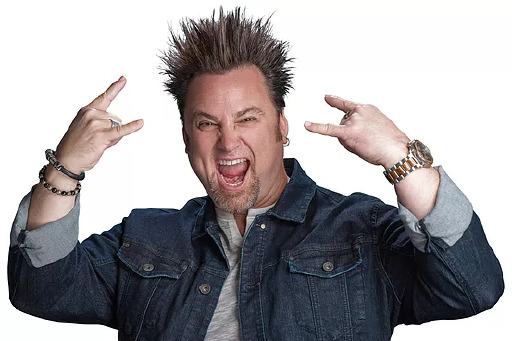 Jim Knight teaches organizations of all sizes how to attain their own “rock star” status. Although his illustrious career started at Gatorland Zoo in Florida (he has scars to prove it), Jim cut his teeth in the hospitality training industry and eventually led Global Training for Hard Rock International for two decades. His customized programs show how to amp up organizational culture, deliver world-class differentiated service, and build rockstar teams and leaders.
Jim Knight teaches organizations of all sizes how to attain their own “rock star” status. Although his illustrious career started at Gatorland Zoo in Florida (he has scars to prove it), Jim cut his teeth in the hospitality training industry and eventually led Global Training for Hard Rock International for two decades. His customized programs show how to amp up organizational culture, deliver world-class differentiated service, and build rockstar teams and leaders.
Known for his signature spikey hair, Jim is the best-selling author of Culture ThatRocks: How to Revolutionize Your Company’s Culture was featured in EntrepreneurMagazine as one of the “5 Books That Will Help You Transform How You DoBusiness”.
His new book, Leadership That Rocks: Take Your Brand’s Culture to Eleven and Amp Up Results, launched in May 2021. A portion of Jim’s book sales, podcast revenue, speaking fees, and training program proceeds goes to No Kid Hungry and Cannonball Kids’ Cancer.
